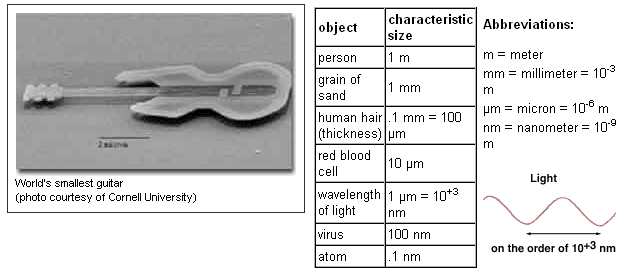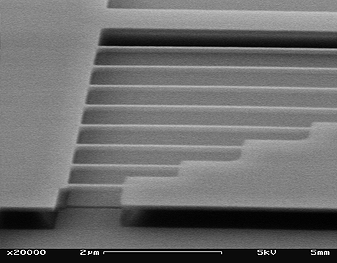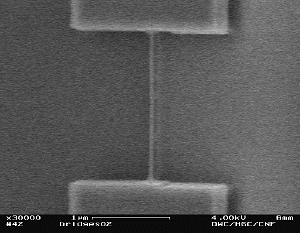Building at the Nanoscale
This guitar is about ten microns
What is a nanometer?
The table below lists some objects, with a characteristic length dimension for each, rounded to the nearest power of ten.

Note that objects that can be seen in an optical microscope, like the human hair and red blood cell, are larger than the wavelength of light.
Resources
Nano-mechanics at Cornell
By building the world's smallest guitar, Cornell researchers showed that they could fabricate recognizable objects at the nano- scale. But, besides the obvious fun of a tiny, tiny guitar, what are the potential applications of this research? Many scientists believe that soon—maybe 50 years from now—tiny robots, the products of this new nano-technology, will be able to build or repair anything at the atomic and molecular level. This is an ambitious undertaking. In the macroscopic world we have a vast understanding of the mechanical properties of materials, but when we are dealing with devices the size of red blood cells, the same mechanical properties can produce different effects.

Electron microscope image of the nano-harp - developed by Cornell researchers to study microscopic resonances. ( Photo courtesy of Cornell University)
Cornell researchers are working to understand resonance and energy-dissipation effects in silicon rods 50 nm in diameter. A radio frequency voltage signal is applied to the rods to make them vibrate. The vibrations are studied by bouncing laser light off the rods and detecting variations in the reflected light.
These rods comprise the "strings" of a nanoharp, cut out of a single crystal of silicon by an electron beam. This beam can produce detail that is on the order of the wavelength of the electrons in the beam. Increasing the electron's energy decreases its wavelength and makes the beam capable of cutting smaller features. The nanoharp is also made using "released silicon" technology, which undercuts the structure so the rods are freely suspended in space.
Near-term applications for these nano-structures include biomedical uses, using the vibrating rods to modulate light, and fiber optic communications.
Links
Craighead research group at Cornell University
More about all kinds of nanotechnology
Images of small living systems

A 30-nanometer-wide wire is suspended across a 2-micrometer gap. (Photo courtesy of Cornell University)














